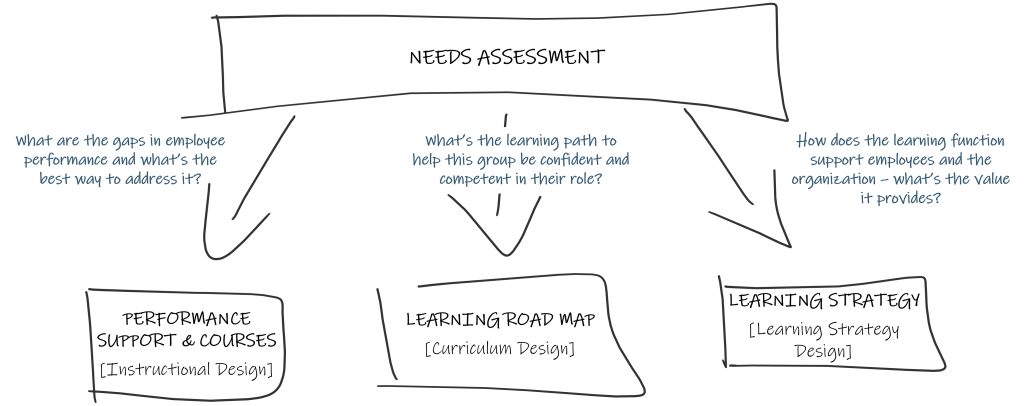You work in a learning and development department in a medium to large organization. The VP, Service Delivery runs the four call centres and has approached you saying,
“Team leaders need training on coaching.”
The VP says the latest Employee Opinion Survey results show that team leaders received a low rating on coaching. You know that the team leaders report to business managers who report to a centre manager. You also know that each team leader manages about 15 to 20 customer service reps who handle inbound and outbound calls.
Can you relate to this type of scenario? How would you respond?
One of the challenges I see when working with clients is that learning and development professionals often feel like “order takers.” Business units or clients come with a problem and a pre-defined solution.
Many learning and development professionals are frustrated because they don’t know if the training they design will address the issue. They don’t know if what they implement will make a difference and change performance. How could the solution possibly have an impact if the need hasn’t been clearly defined?
What is a needs assessment?
A needs assessment is the process of analyzing different factors that are causing performance issues so you can identify the best solution – whether it is a training course or non-training solution. I follow the Institute for Performance and Learning’s Competencies for Performance and Learning Professionals. Here’s how it describes the competency, Assessing Performance Needs:
… can range from … a few hours to clarify what learners should be able to do after training, to … weeks to conduct a needs assessment of a complex performance issue …
… the most complex of the competency categories … also involves a number of other, inter-related competencies …
If the solution you identify includes training, it’s important to design with the end in mind. By spending time upfront identifying what is causing the performance issue, you can create a program that will address that area specifically and generate the change in performance you’re looking for. Without a training needs assessment, you run the risk of spending time and money on training courses that have little impact.
Needs assessment for individual courses and larger programs
I work with clients in these three areas:
- Learning Strategy Design – align learning and development initiatives to the organization’s goals.
- Curriculum Design – create learning road maps that outline the employee’s learning journey.
- Instructional Design – offer programs to create micro and macro course for in-person, virtual, and elearning delivery.
I find that needs assessment is an important first step in supporting all of these areas of learning design. The question you ask changes slightly.

Instructional Design
If you’re looking at an individual role or employee performance, your focus will be on the gap between the current state and the desired state.
- Find out what employees are employees currently doing, which is incorrect or not to standard.
- Ask about what they should be doing instead.
- Define this gap and identify what’s causing it. Look for causes at the job level, issues with processes and broader organizational impacts.
- Identify the best way of addressing the gap in performance. If it’s a knowledge or skill issue, training is a great approach. If it’s not, consider a non-training solution like coaching, a job aid, or better manager direction and feedback.
The output of this needs assessment will be a gap analysis and recommendations for a training or non-training solution.
Curriculum Design
If you’re looking at a group of employees, your focus will be on the learning path. I consider three areas in the assessment phase:
- Outcomes – Identify the performance outcome and how it supports the organization’s goals.
- Audience – Define the group(s) of learners so you can ensure the approach will meet their needs.
- Environment – Define the broader context for the program, including the technology available, the work environment, existing programs, etc.
The output of this needs assessment will be a learning road map. The learning road map should answer these questions:
- WHO – Who is the program – which group or group(s) of employees?
- WHAT – What are the topics they will learn and apply to their job?
- WHEN – When do they learn which topics – what is the sequence?
- WHERE – Where do they access the learning – is there technology they need access to?
- WHY – Why are they doing this – how will it help them in their job?
- HOW – How will they learn – online, virtually, in-person?
Learning Strategy Design
If you’re looking at the learning function overall, you’re focused on a learning strategy. Like a curriculum design, I consider three areas in the assessment phase:
- Outcomes – Clarify the organization’s strategy and how the learning function can support it and the employees.
- Audience – Define the group(s) of employees the learning function supports so you are clear about their needs and in what areas the learning function has ownership.
- Environment – Define the broader context for learning and development, including the technology available, the work environment, existing programs, etc.
The output of this needs assessment will be a learning strategy with recommendations and a plan for implementing the strategy.
Often clients confide that they’re worried their team designs programs and nothing seems to make a difference. They wonder if what their team does even matters. And, if they can’t demonstrate the value they provide, will their budget be the first to be cut in a recession. By taking the time to do a needs assessment, even a short one, you position your programs to address actual performance needs and create a foundation for evaluating the impact of your solutions.
In case you missed it
I’ve shared some additional posts online. Here they are in case you missed them.
- Learning Strategy virtual or in-person – (link)
- Learning Strategy – in-house or outsource – (link)
- Learning & Development ownership – (link)
- Learning Value Proposition – (link)



